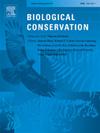Not seeing the tree for the Forest: Scattered trees can be unexpected hotspots of fungal diversity
IF 4.9
1区 环境科学与生态学
Q1 BIODIVERSITY CONSERVATION
引用次数: 0
Abstract
Scattered trees are hubs of biodiversity. Here, we present a study in which fungal communities in the caulosphere of scattered individual trees were compared to those of woodlands. We compared alpha and beta diversities of wood- and bark-inhabiting fungi from the stems of trees across seven vegetation types belonging to three species: Pinus muricata, Quercus agrifolia and Notholithocarpus densiflorus. Scattered pines were among the investigated vegetation types. Correlations between stand density, or other tree features, and alpha diversity matrices, were studied with six Generalized Linear Models (GLMs), while the effect of spatial dispersion of trees was studied by correlating Ripley's K values with diversity. Results show that scattered trees represent a hub for biodiversity of wood and bark fungi. We found that caulosphere fungal richness in scattered pines was higher than that of pines growing in stands and was as high as that in notoriously biodiverse oak woodlands. Beta diversity analyses showed that the high fungal diversity in scattered pines is explained by the large number of taxa unique to pines, by a significant overlap of fungi between scattered pines and other vegetation types, and by a significant number of fungi unique to scattered pines. The GLMs showed significant correlations between high species richness, Shannon's and Simpson's indices and low forest density. Finally, we show that the fungi in or on the stems of more dispersed vegetation types are more diverse. These surprising results suggest that preserving or planting scattered trees is a cost-effective strategy that could support as much, or even more, caulosphere fungal biodiversity than entire woodlands.

求助全文
约1分钟内获得全文
求助全文
来源期刊

Biological Conservation
环境科学-环境科学
CiteScore
10.20
自引率
3.40%
发文量
295
审稿时长
61 days
期刊介绍:
Biological Conservation is an international leading journal in the discipline of conservation biology. The journal publishes articles spanning a diverse range of fields that contribute to the biological, sociological, and economic dimensions of conservation and natural resource management. The primary aim of Biological Conservation is the publication of high-quality papers that advance the science and practice of conservation, or which demonstrate the application of conservation principles for natural resource management and policy. Therefore it will be of interest to a broad international readership.
 求助内容:
求助内容: 应助结果提醒方式:
应助结果提醒方式:


